Picture Perfect
Gaining quality assurance via the use of an exacting camera.
Latest News
November 1, 2006
By Belinda Jones
While it’s a safe bet that George Eastman, the inventor of the box camera, never imagined that his brainchild would be used by aerospace engineers to capture micro-precision 3D coordinate data, he did envision the endless possibilities of a device so portable and so adaptable to any setting that the future would embrace the art of capturing images. In fact, his advertising slogan, “You press the button, we do the rest,” is as timely today as it was in the 1890s.
Photography has since combined with metrology to give rise to a technology called photogrammetry. This 3D-coordinate measuring technique had its beginnings in the early 1970s when civil engineers and surveyors began using photogrammetry for measuring and creating large 3D topological maps. Soon, industrial engineers were looking to reap the same precision for inspection and measurement.
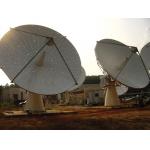 |
| Image courtesy Weston Antenna. |
> > Photogrammetric surveys were conducted on these 10-meter-diameter Ku-band antennas to determine primary surface adjustments, and evaluate sub-reflector and feed alignments.
Photogrammetry is now used for in-place measurement and verification of large parts and assemblies, tooling inspection and adjustment, test-retest measurement, deformation studies, part inspection, tamoana (disassembly and reassembly) studies, and more. This technology is also used by research laboratories and by engineers in industries ranging from aerospace to shipbuilding.
The technique works by virtue of triangulation. By taking photographs from at least two different locations, so-called “lines of sight” can be determined from each camera position to points on the object. These lines of sight, sometimes called rays due to their optical nature, are mathematically intersected to produce 3D coordinates of the points of interest.
Not George Eastman’s Box Camera
Like the camera industry, photogrammetry has made the transition from film to digital imaging. Unlike the shutterbug of yesteryear, today’s photogrammetry operator will likely use an INCA3 digital camera developed by Geodetic Systems, Inc. of Melbourne, FL. This 8-megapixel camera integrates a high-resolution CCD (charge-coupled device) sensor with a compact industrial PC-based computer and V-STARS photogrammetry software. This combination can capture field measurements with an accuracy of better than 0.001 in. at a distance of 160 inches in most any industrial setting with or without laboratory conditions.
Over the past decade, this photogrammetric camera has transitioned to a sturdy, lightweight design with advanced calibration features and (WIFI) wireless less than half the size and weight of its two predecessors. The entire system, including the camera, notebook computer, and interface hardware, weighs less than 13 pounds. Due to its portability, photogrammetric measurements have been conducted everywhere from under the ocean to space (and everywhere in between) on objects both larger and smaller than a football field.
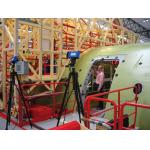
< < There are two major applications of photogrammetry at AIRBUS: periodic testing of large-scale construction fixtures and fuselage section interface measurements. The quality assurance group at AIRBUS also uses the photogrammetry system to perform wing measurements and deformation measurements during testing.
The camera can operate independently of the computer via hand-held operation or remote control with digital images captured on a Compact Flash (CF) memory card to be downloaded to the computer at a later time. When connected via WIFI or its thin, combined power and network cable, photographs can be measured immediately. Users can also operate multiple cameras simultaneously online for real-time measurement of dynamic or static objects.
Measuring with Photogrammetry
Measuring industrial objects with photogrammetry usually consists of the following steps: planning the measurement, targeting the object, taking pictures, measuring pictures, processing pictures to obtain 3D coordinate data, and analyzing the results. Since every measurement project is unique, the content and even the order of the steps given above may be changed depending on project requirements and user preference.
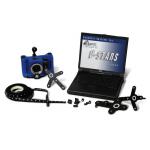
> > V-STARS is also used by industry for many unconventional applications. Photogrammetric surveys have been performed in arctic weather, equator-like temperatures, underwater venues, remote mountainous areas, and high above the Earth. In many cases, the inherent flexibility and versatility of digital photogrammetry make it the only technology capable of such metrology ventures.
For some jobs, the camera operator might shoot all the photographs first to minimize time onsite, then measure them later. Other tasks require the operator to shoot and measure each picture immediately after it is taken. An operator might also choose to take and measure a few photographs, and process them instantly to get preliminary results. This makes measuring the remaining photos easier.
There are a variety of ways to capture points of interest on an object. Targeting is just one method used in close-range photogrammetry. The photogrammetry system measures special targets made of a thin 0.1mm thick (0.004 in.) grayish retro-reflective material that resembles highway reflectors. It returns light very efficiently to the light source, and is typically 100 to 1000 times more efficient than the conventional white targets on a black background.
The photogrammetric camera does not measure the object directly, but measures the center of the retro-reflective target. By placing the target on or in a known relationship to the point of interest, the point can be measured. In some circumstances, it might be difficult to target the point you want to measure directly. Fortunately, many different types of retro-reflective targets have been developed to solve this issue.
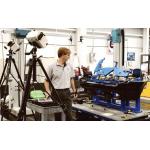
< < At BMW Manufacturing, the quality-control team performs both online and inline inspection tasks using photogrammetry. Online measurement in the plant means the metrologist is collecting data “in the process” while it is, or is not, moving. Inline measurement is an integrated part of the process and is performed continually.
Target points that are specifically designed into a CAD model, then machined directly into the tooling, can be easily tracked by a quality assurance professional. These precisely made tooling targets are located in bushed holes, or they may be defined by features on the measured object, such as part edges or hole locations that are targeted in some way.
Once an object is targeted, the camera’s low-powered flash illuminates the targets and makes exposure of the targets independent of the ambient light level. This means the object can be photographed in bright light or total darkness, with the target exposure remaining the same. By properly setting the shutter exposure time, the camera operator can expose the object to the desired level.
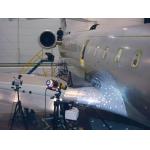
> > The PRO-SPOT projector-like device casts thousands of dots upon an object’s surface and measures them in a few seconds.
Since photogrammetry measures by triangulation, in theory only two photographs are required for a measurement. However, a minimum of four to six photographs is recommended because this range allows the operator to self-calibrate the camera.
Moving Forward
George Eastman’s legacy thrives as the digital photography revolution has breathed new life into the science and art of picture taking. The digital imaging industry is spawning technological advances at a record pace, and photogrammetry is a chief beneficiary. As metrologists and engineers continue to create and expand their inspection programs, photogrammetry evolves around those customer needs and blazes new trails in dimensional maintenance and portable measurement.
Belinda Jones is the founder and principal of Connecticut-based HiTech Marketing LLC. She has been writing about engineering, manufacturing, and quality assurance topics for more than a decade. Send your comments about this article through e-mail by clicking here. Please reference “Picture Perfect, November 2006” in your message.
Photogrammetry Unplugged
While targeting has long been the mainstay in photogrammetry, Geodetic’s PRO-SPOT leverages techniques pioneered by the company. This projector-like device casts thousands of dots upon the measurement surface and measures them in less than one minute. Designed with large objects in mind, this system generates fast, accurate, dense, noncontact measurements on large surfaces such as molds, master models, panels, antennas, and other components.
When the projector is used with a single camera, the operator measures static objects by taking photos from various locations. When the projector is used in conjunction with two cameras, this system can actually “freeze” the dots on the object and accurately measure moving objects or objects undergoing deformation by virtue of the dual-camera synchronization. The process and expense of targeting is eliminated, as is the need for probes or reflectors. The set-up is simple and the system can be configured for fully automatic measurement.
Another advancement in photogrammetric data collection is the I-CAN, a completely self-contained camera canister developed for thermal vacuum environments. The I-CAN wraps around the INCA3/V-STARS camera system and keeps it cool with a dry nitrogen purge. The instrument’s design includes a rigid, optically flat quartz window created to maintain accuracy. This camera configuration has built-in heating and flash systems, internal camera roll, and a thin cable for power and data connections. The controller can handle up to three cameras and canisters. With notebook computer operation, two or more I-CANS can obtain dynamic, real-time measurements. —BJ
Contacts
Geodetic Systems, Inc.
Melbourne, FL
Subscribe to our FREE magazine, FREE email newsletters or both!
Latest News
About the Author
DE’s editors contribute news and new product announcements to Digital Engineering.
Press releases may be sent to them via [email protected].






